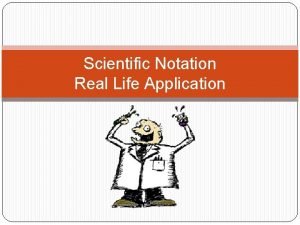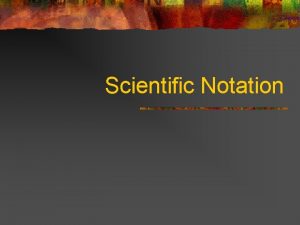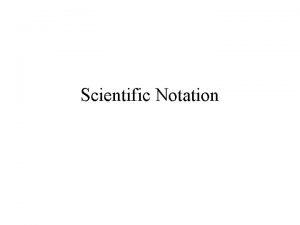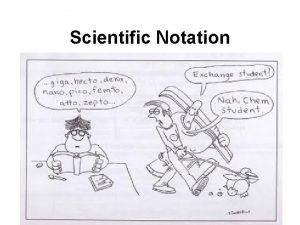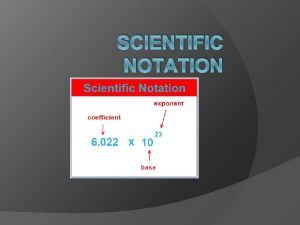Scientific Notation Real Life Application Focus 11 Learning






- Slides: 6

Scientific Notation Real Life Application

Focus 11 - Learning Goal: The student will be able to work with integer exponents. 4 3 2 1 0 In addition to 3, student will be able to go above and beyond by applying what they know about working with integer exponents. The student will be able to work with integer exponents. - Know and apply the properties of exponents. - Simplify numerical expressions with exponents. - Perform operations with scientific notation. With no help the student has a partial understanding of integer exponents. - Is able to use scientific notation to estimate very large or very small numbers. - Interpret scientific notation generated by technology. With help, the student may have a partial understanding of how to work with integer exponents. Even with help, the student is unable to work with integer exponents.

Earth and the Sun �Light travels at approximately 3. 0 • 105 km per second. The light from the sun takes approximately 500 seconds to reach Earth. Approximately how many kilometers apart are the sun and Earth? �Step 1: Write both numbers in scientific notation. � 3. 0 • 105 & 5 • 102 �Step 2: Multiply numbers � 3(5) = 15 �Step 3: Add exponents � 105 & 102 » (5 + 2 = 7) » 107 �Step 4: Write in proper scientific notation. � 15 • 107 = 1. 5 • 108 km

Bacteria �One organism of a certain bacteria has a mass of approximately 1. 1 • 10 -12 grams. After 2 months, this certain bacteria can reproduce into 3. 1 • 1025 total bacteria. What would be the mass (in grams) of all of these bacteria? �Step 1: Write both numbers in scientific notation. � 1. 1 • 10 -12 & 3. 1 • 1025 �Step 2: Multiply numbers � 1. 1(3. 1) = 3. 41 �Step 3: Add exponents � 10 -12 & 1025 » (-12 + 25 = 13) » 1013 �Step 4: Write in proper scientific notation. � 3. 41 • 1013 grams

Real Facts �The average child has a total of 2. 7 • 105 germs on their hands. How many total germs are there in a classroom of 30 kids? What about in a school of 950 kids? �Step 1: Write both numbers in scientific notation. Now for 950 kids: � 2. 7 • 105 & 3. 0 • 101 �Step 2: Multiply numbers � 2. 7(3. 0) = 8. 1 �Step 3: Add exponents 2. 7 • 105 & 9. 50 • 102 2. 7(9. 50) = 25. 65 105 & 102 » (5 + 2 = 7) » 107 2. 565 • 108 germs for 950 kids. � 105 & 101 » (5 + 1 = 6) » 106 �Step 4: Write in proper scientific notation. � 8. 1 • 106 germs for 30 kids

Calories �A typical teenager should consume approximately 2500 calories per day. In America, there approximately 3. 3 • 107 teenagers. How many total calories should be consumed by teenagers in one day? �Step 1: Write both numbers in scientific notation. � 2. 5 • 103 & 3. 3 • 107 �Step 2: Multiply numbers � 2. 5(3. 3) = 8. 25 �Step 3: Add exponents � 103 & 107 » (3+ 7 = 10) » 1010 �Step 4: Write in proper scientific notation. � 8. 25 • 1010 calories
